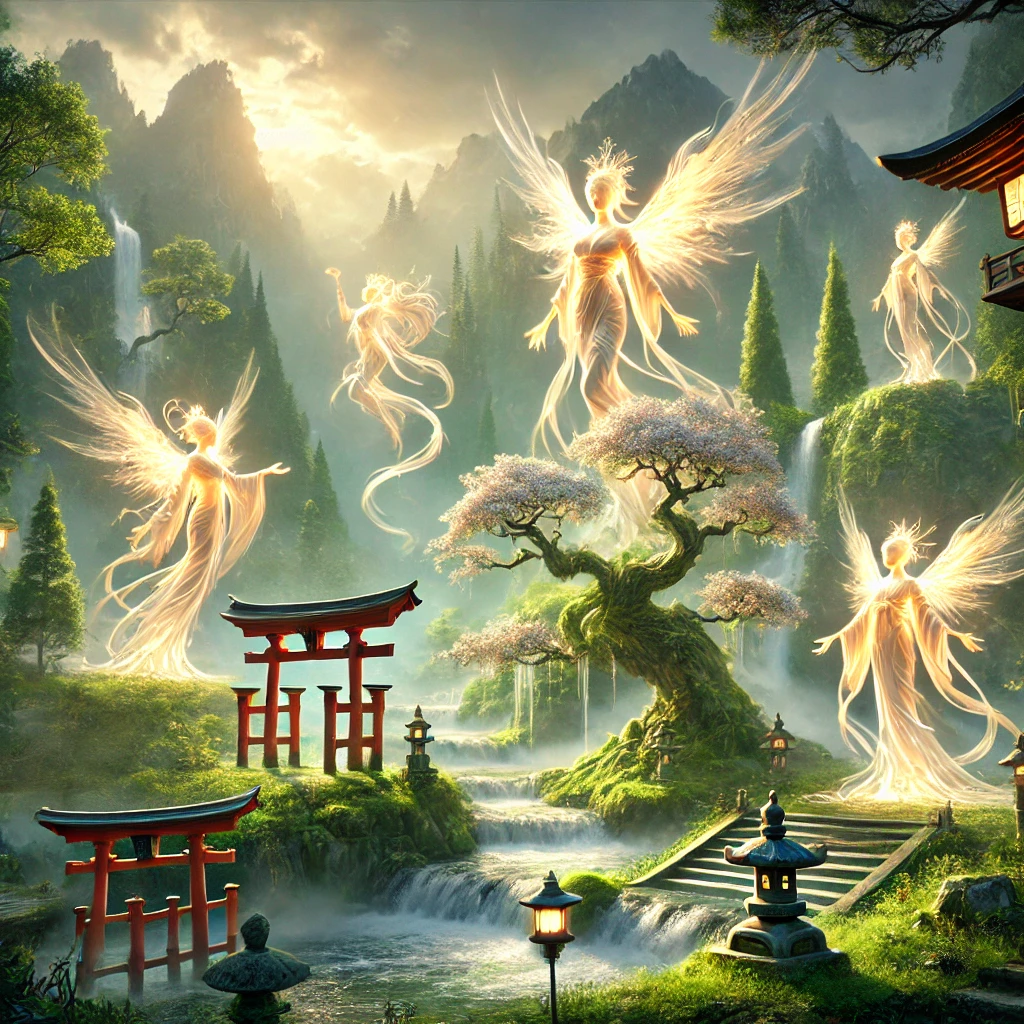Overview
Kami are the sacred spirits or divine forces revered in Shinto, the indigenous spiritual tradition of Japan. They inhabit all aspects of the natural world—mountains, rivers, trees, rocks, wind, animals, and even human ancestors. Rather than being separate gods, Kami are viewed as the spiritual essence within all things, especially those that inspire awe, wonder, or reverence.
In Shinto belief, the world is alive with Kami. This understanding fosters a deep sense of respect for nature, gratitude for life’s blessings, and a spiritual relationship with the environment. Kami are not omnipotent beings but are guardians, guides, and embodiments of natural harmony, each with their own personality and domain.
Origins and Definition
- The word Kami (神) translates roughly as “spirit,” “deity,” or “divine being”, but the concept is broader and more nuanced.
- Kami are not confined to a single form or identity; they can be forces of nature, ancestral spirits, heroic figures, or mythological beings.
- The Kojiki and Nihon Shoki, Japan’s earliest written records, describe Kami as emerging during the creation of the world, shaping the islands of Japan and imbuing them with sacred presence.
Types of Kami
| Type | Role or Domain |
|---|---|
| Amatsukami | Celestial Kami, often connected to the heavens and mythology |
| Kunitsukami | Earth Kami, tied to natural features like forests and rivers |
| Ujigami | Ancestral Kami, guardians of families or local communities |
| Nature Kami | Spirits of trees, mountains, waterfalls, animals, stones, and more |
| Man-Made Kami | Spirits believed to reside in objects, tools, or places treated with reverence |
Kami are considered immanent, not distant—they dwell among us, and their blessings or displeasure are reflected in the flow of life, health, harvests, and harmony.
Spiritual and Cultural Significance
1. Embodiments of Sacred Presence
Kami represent the sacredness within the world, inspiring humans to live in balance with nature and community. To encounter a Kami is to feel a profound sense of awe, known as kannagara—living in accordance with the way of the Kami.
2. Guardians of Place and Life
Every village, shrine, mountain, and river may have a local Kami, known as a Chinju no Kami, who protects that place and its people.
3. Mediators of Harmony
Kami are concerned with purity, order, and gratitude. When humans honor these principles, blessings flow. When they are neglected, imbalance may result, and rituals of purification (harae) are needed.
Shrines and Sacred Spaces
- Shinto shrines (jinja) are built to house Kami and create a sacred space for human connection with them.
- A torii gate marks the threshold between the mundane world and the sacred dwelling of the Kami.
- Kami are honored through offerings, prayers, festivals (matsuri), and acts of daily reverence.
Many natural places without buildings are also considered sacred and are worshipped directly—a mountain, a waterfall, or an ancient tree may be a Kami in itself, with a simple rope (shimenawa) or marker indicating its sacredness.
Practices for Honoring Kami
1. Reverence in Nature
- Treat natural places with respect and gratitude. Avoid harming plants, polluting water, or disturbing sacred spaces.
- Acknowledge the Kami of a place before entering—silently bow or offer thanks.
2. Purification and Cleanliness
- Shinto emphasizes ritual purity, both physical and spiritual. Wash hands and mouth at a shrine’s purification basin (temizuya), or cleanse energetically with water before prayer or ritual.
3. Offerings and Devotion
- Offer rice, sake, salt, fruit, or flowers at shrines or sacred altars as symbols of gratitude.
- Daily life can become a form of devotion—acts done with mindfulness and harmony are offerings to the Kami.
Signs of Kami Presence
- A deep sense of awe or peace in nature
- Subtle signs or synchronicities near shrines, trees, or sacred places
- Animal messengers such as foxes (Inari), deer, or cranes appearing with significance
- Unexpected clarity or intuitive insight after making an offering or prayer
- The presence of a shimmering or heightened energy in certain landscapes
Well-Known Kami in Mythology
| Kami | Domain |
|---|---|
| Amaterasu | Sun goddess and central deity of Shinto; light and life |
| Susanoo | Storm god, brother of Amaterasu; change and cleansing |
| Inari | Kami of rice, agriculture, prosperity; fox messengers |
| Konohanasakuya-hime | Kami of cherry blossoms, volcanoes, and sacred beauty |
| Ōkuninushi | Earth Kami of healing, nation-building, and relationships |
Each Kami reflects aspects of nature, human experience, and cosmic order, forming a diverse spiritual ecosystem.
Teachings and Wisdom of Kami
| Theme | Spiritual Insight |
|---|---|
| Purity | Keep your heart and actions clean—clear intention brings blessing |
| Harmony | Live in balance with nature, others, and self |
| Gratitude | Offer thanks daily to the spirits that support your life |
| Respect | Honor the sacred in all things, especially the quiet and unseen |
| Presence | The divine is not distant—it lives in every tree, river, and breath |
Conclusion
Kami are not only spiritual beings but reflections of the living spirit within nature, calling us into a deeper relationship with the Earth and each other. They remind us that the world is sacred—not in some distant mythic past, but here and now, in every leaf, breeze, and moment of reverence.
By honoring the Kami, we learn to walk gently, live gratefully, and participate in the sacred dance of life, attuned to the invisible forces that sustain harmony across both the seen and unseen worlds.

